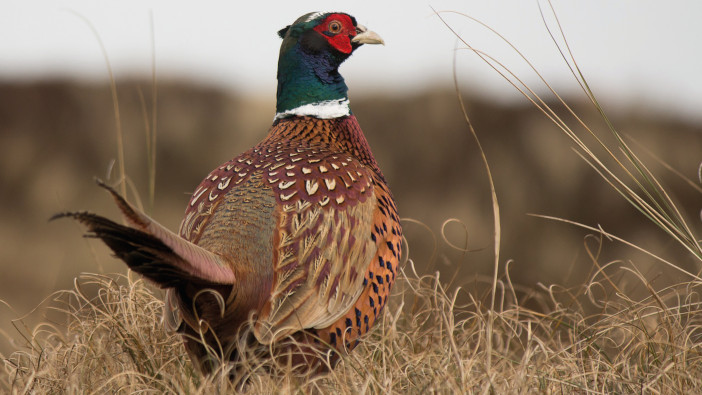Game changers: the game market has been through some turbulent times over the past few years. But Liam Stokes is on a mission to make this sustainable sector bigger, and more profitable than ever before.
Liam Stokes is chief executive of British Game Assurance (BGA), an assurance scheme for the game sector. He took up his role two and a half years ago, and has held the role during some of the most turbulent years for the sector in memory.
The role of the BGA is to promote, develop and assure game meat, and as part of his role, Stokes tries to open new routes to market and drive value into meat that historically has been treated as a by-product of shooting.
The BGA’s assurance schemes are administered through FSA Global, and operates throughout the shot game market through from laying stock up to the shoot gate.
Completely mad

The game sector is unusual in that the market is driven not by demand for game meat, but by demand for the game shooting – pheasant, partridge, guinea fowl and quail. “The economics are completely mad because supply and demand just doesn’t work,” says Stokes.
The various lockdowns during the past two years not only threw the whole shooting season off, but closed one of the main route to market for game meat – the hospitality sector. Only now is the industry starting to get back on an even keel, and has immediately been dealt another dud hand with the huge challenge of avian influenza (AI).
Despite this, Stokes believes game has a bright future ahead if it can tap into its unique selling points of being sustainable, wild and healthy.
In the UK, the game season runs from 12 August (the glorious 12th) to 1 February, and moves through different species, starting with grouse, then partridge, wild duck and geese, then woodcock and pheasant.
The nature of the market is that it is very fragmented, with meat sold through multiple local channels, and it is therefore hard to get reliable data understanding the size and value of the market. Driving value back into the game market is one of Stokes’ main priorities, but first there are some big obstacles to overcome.
Freezer stocks
Around five or six years ago, the value of game collapsed. Shooting had become more popular, and so the value of the initial product – the bird in feather at the end of a shoot – fell away. According to Stokes, the price paid for shooting worked out at around £40 or £50 for a bird while it was in the air, but once shot, the value evaporated.
As a result, a lot of game meat ended up being frozen. “There were some rather lurid rumours at the time about what was actually happening to all that shot game, but the reality was the vast majority of it was being frozen,” he says.
This compounded the situation the following year. “With unknowable frozen stocks of game, dealers didn’t have to offer a price. They were saying ‘we will come and get it, but we won’t pay for it’. Trying to move the dial on that to get dealers to pay for birds is one of our key objectives.” The freezer stocks have for the past few years acted as a buffer preventing the value of game from growing.
The situation was further complicated (and in one sense eased) by the covid pandemic. The shooting season was disrupted for obvious reasons during the 2020 to 2021 season and again during the 2021 to 2022 season. Only around half the normal volume of birds were shot, Stokes says. The effect of that was to empty the freezer stocks, which was welcome.
The BGA directed its attention during these winters towards retail rather than hospitality, with success. Stokes says he is now “quite confident” there is a “genuine relationship” between what is being shot and what is being provided to the market.
The true cost
One of the reasons the price paid by dealers for game meat has traditionally been low, is because it is a complicated and time-consuming product to process. Unlike animals slaughtered in a controlled way in an abattoir, game in feather must be moved to a processing facility which may be many miles from the place it was shot.
“Everything that I believe makes game a premium option also makes it incredibly inefficient,” says Stokes. “It is shot in remote places which makes it expensive to go and collect it. You’ve got the cost of going out there to collect it, and it is shot on the wing rather than going through a mechanical process of slaughter and that means there is quite a lot of wastage.”
One of the major challenges, says Stokes, is educating the shooting community on how to deal with game as food from the second it’s shot. “You’re not necessarily seeing it being chilled as rapidly as it should be,” he says, meaning by the time it gets to the dealer there is potentially additional wastage. “You also have lots of different breeds of birds which makes processing inefficient.”
This season, the industry is starting to see money changing hands for shot game. “Finally, now it is attracting a value,” says Stokes. “Not a lot but, it is attracting a value.” In September, when partridge and duck were in season, shot duck and partridge was being sold for around 20p per bird, with pigeons at around 15p.
Lead-free ammunition
Another major change the industry is going through is the transition to lead-free ammunition. Although it’s a controversial topic within the game sector, retailers including Waitrose have demanded that the game meat sold in its shops does not contain any lead.
This has been a difficult process to manage as lead is a “ballistically perfect” metal with which to shoot, says Stokes. “Lead has the ideal blend of density and weight, which serve to make it an extremely effective projectile. It is also extremely humane because of those properties,” he says. It is also soft, meaning it is kind to the barrels of the guns.
Changing to alternatives, such as steel, is not straightforward. Steel is much harder and lighter. “It needs to be fired much more rapidly through the barrel because it is lighter and to move a projectile faster you need greater pressures, so the combination of pressure and speed carries with it a greater risk of damage to the firearm,” says Stokes.
Despite these challenges, the combined shooting organisations announced a five-year transition away from lead in 2020, meaning the process must be complete by 2025. “That was very unpopular in some circles, but it was a brave call and it was the right call for the food market,” says Stokes.
Size of the market
Because of the lack of comprehensive data, it is hard to get a handle on the size of the market. However, Stokes says that pre-covid, there were around 18 million game birds being shot each year.
Around a third of those, six million were being sent through major processors. A further six million were being exported. Similar to other meats, the game sector has to balance the carcase effectively, and this means some cuts can find a greater value on the Continent.
The remaining third – the final six million – are really hard to keep track of, says Stokes.
“There are two exemptions in wild game guide that allows shoots to sell directly to small businesses such as local pubs, hotels, and small restaurants, plus small butchers and farm shops.” This is where the remaining six million birds end up.
Processing is carried out by a combination of large BRC accredited premises that largely supply the supermarkets, such as Lincolnshire Game. Other processors including Hampshire Game, Willow Game and Braehead also process game birds.
Avian flu
The game market has had several tough years to contend with, and this season is no different, with the unprecedented AI outbreak causing new problems for shoots and the movement of game birds.
“We are looking at another reduced season,” says Stokes. Because of this, shoots that can take place outside of prevention and surveillance zones will be more valuable than usual.
Housing orders are now in place in England, Wales and Northern Ireland, but although these prevent the release of game birds, they don’t prevent shooting of birds that are already released. “It has already taken an enormous toll on the season,” says Stokes, but until spring it won’t be clear just how much disruption there has been across the year.
Avian flu across Europe has already had a big impact on the sector. A proportion of game bird eggs are laid in France then imported to the UK. The wave of AI that swept across France in the spring led to what Stokes describes as a “dawning recognition” that many shoots would not be receiving their birds.
He says around 40% of shoots have been able to continue without problem, while about 20% were going to wrap off altogether and then the remaining 40% were on “some short of reduced spectrum. The smaller the shoot the more chance they will be affected,” adds Stokes.
Larger shoots tend to be the ones supplying larger processors and in turn have the contacts with supermarkets. The smaller shoots that supply smaller butcher’s shops and pubs might be though.
Several shoots have been hit by AI outbreaks directly, says Stokes. Although the Food Standards Agency (FSA) says those birds are still safe to eat, the processors are unwilling to take them, because bringing birds in from affected zones means they will lose their export licences.
This disruption is very inconvenient. But, says Stokes, there is a possibility that on the positive side, it could shake up the local market for game, and lead dealers to find new customers locally for game meat.
“It might reinvigorate local shoots,” says Stokes. “There has been a tendency within game for processors and shoots to act as if they belong to each other. There is a reticence to look around and see if there is anyone offering higher prices and that has a chilling effect on the price of game. This might be the season where that changes.
“Obviously from a negative point of view, less game is going to be exported and actually that might dry up altogether and then we might see the situation where freezes are getting refilled.”
Optimism
Despite all these many challenges, Stokes describes himself as “incredibly optimistic” about the future. “It’s been three incredibly difficult seasons for the people on the ground, but the overall trends are absolutely in game’s favour.
“I’ve worked in game shooting for 15 years and these are birds that spends their life in the wild, are shot where they live. You cannot manage game without planting trees and looking after the environment and planting hedgerows, so by choosing to buy it you are supporting the management of the countryside.
“It is really exciting that as we emerge from the cost of living crisis and lift our eyes above the horizon, we have got an entire nation thinking about where should food be coming from.” Awful global events such as the war in Ukraine have disrupted food supply chains and local supplies of food such as game may end up benefitting, adds Stokes.
“People say you can’t feed the nation with game. Well, of course not. But it is about giving people the opportunity to invest in the countryside and enjoying something different on their plate.”
Read more
Have a look at the Game section of our news site


